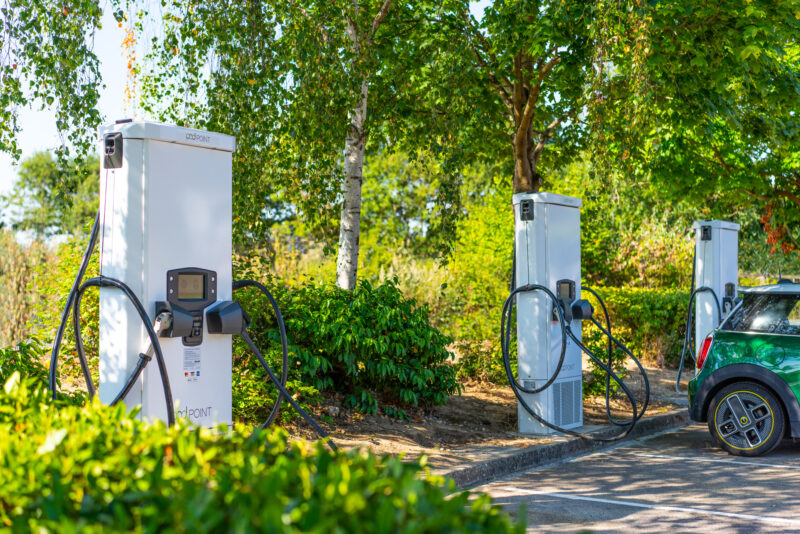Electric Vehicle Charging Etiquette
A guide to the etiquette around the use of public and workplace EV charging points.
Last updated: Aug 01, 2024 • 7 min read

Summary
It is important to be considerate when charging your EV so that you don’t inadvertently prevent other drivers from charging when they need to. We’ve pulled together the key areas of charging etiquette that you should be aware of:
- The Golden Rule of EV Charging Etiquette
- Rapid charging etiquette
- The 5 Chargepoint Commandments
- Workplace charging etiquette
- General etiquette tips
The Golden Rule of EV Charging Etiquette
Electric vehicle charging points are for charging plug-in vehicles only
A seemingly obvious statement, but there are two parts:
1. Plug-in vehicles only!
Unless your car can make use of a charging point then this bay is not for you. Parking an “Internal Combustion Engined” (ICE) car in a charging bay is known as “ICE'ing”. It will win no one any friends, nor admiration.
2. Charging only!
Even if it is a preferable space, you should only park in the bay by the EV chargepoint if you are going to charge!
When you are at a public chargepoint it’s also considerate to move once you have completed charging to allow another driver use of the chargepoint.
Of course there are some chargepoints where this isn’t possible, e.g. at airports or train stations - so use your initiative.
Tip: You often don’t need to charge to 100% before moving. It is likely you can continue your journey with less, so consider moving once you have got to what you consider an appropriate threshold. However, someone using a top-up AC chargepoint to charge their car is never wrong - that is what the charger is for. If other drivers need to charge too then the solution is to get more chargepoints!

Rapid charging etiquette
1. Do not block the bay with an internal combustion engine vehicle.
This is the equivalent to finding you are blocked from entering a petrol station you really need by someone parking across the only available entrance. The rage is palpable.
2. Don’t use a rapid charger if your plug-in vehicle can’t rapid charge.
Some rapid chargers have AC sockets which some EVs that can’t rapid charge can technically top-up charge on.
Most PHEVs (and some BEVs) can only charge at the slower AC charging rates. If not an emergency for a BEV driver, they should avoid rapid chargers while PHEV drivers should do the same, as they can continue travelling using fossil fuel by virtue of being a PHEV.
It is not an appropriate use of a rapid charger to charge at 3.6kW or 7kW, potentially for hours, blocking a BEV who needs to use it for their onward journey.
3. As soon as you have charged as much as you need, unplug and vacate the bay straight away.
The rapid charger is not for parking at. It’s for charging and moving on from. This is one of the reasons for The Rapid Charge Paradox (“The faster the charger, the longer you spend watching your car charge”) - you can’t go far from a rapid charger while using it. While inconvenient this is about being considerate to other users. And increasingly drivers who leave their car charged and plugged in will be hit with “idle fees” for overstaying.
Tip: Not only is it kind to head off before your car has rapid charged to 100%, it is an efficient use of time. The last 10% of your battery typically charges quite slowly, so it is quicker to get going when you reach circa 85% either to charge at the next en route rapid charger, or, better still, to charge at your destination.
The 5 Chargepoint Commandments
- Thou shalt not ICE.
- Thou shalt not park in a charging bay, unless to use the chargepoint.
- Thou shalt not unplug thy neighbour.
- Thou shalt leave the rapid charger as soon as you have finished charging for your onward journey.
- Thou shalt not covet the (appropriately used) charger of thy neighbour.
Can someone unplug my electric car?
Unplugging someone’s car is usually impossible in practice, there are locking mechanisms in the car-side Type 2 socket and some Type 1 sockets. However, some Type 1 cars can still be unplugged by a 3rd party.
While it’s not illegal for someone to unplug your electric car without your consent, it’s bad EV charging etiquette. As long as you vacate your spot once you’re done charging, this shouldn’t be an issue.

Workplace charging pointers
You are unlikely to need the charger for the whole day, but depending on your job/how busy your day is, it can be tricky to move. Thus:
- Try to move if there’s demand from other drivers - maybe leave a note with your number?
- Don’t get too grumpy with colleagues if they can’t move.
- Get more chargepoints installed!
If you have any further queries then we recommend speaking to our Workplace team or checking out our Workplace EV charging solutions page.
Tip: Workplace charging is an absolutely critical part of the charging ecosystem, and a great opportunity to charge, particularly for those without home charging. There is also a Workplace Charging Scheme grant available for businesses, which reduces the cost of chargepoints.
General etiquette tips
Some basic etiquette makes everyone’s lives easier, so here are our top chargepoint pointers:
- It is better to be philosophical about other people abusing the commandments. You will quickly forget about the annoyance. You will not soon forget about a conviction for criminal damage.
- Try to match rapid charge events with similar length activities - coffee in a local café, a similarly timed walk, use of facilities. Watching your car charge is no one’s idea of fun.
- Try not to use the last possible en route rapid charger, ideally use the one before the penultimate. This gives you a safety buffer should it be occupied or out of service, as you have two more to try ahead of you.
- Try to get into the habit of topping up at your destination whenever you can. Whilst this feels alien for those used to refuelling, it reduces your reliance on (usually) expensive and inconvenient rapid charging and means charging happens when you are busy doing other things, thus minimising your time spent waiting to effectively nil.
Can I sit in my car while charging?
Yes, you can sit in your electric car while charging as long as you leave your bay once you’re done. Although some have previously raised concerns over the possibility of EV charger current interfering with certain medical devices in human bodies, a study published in the journal of the European Society of Cardiology found no proof of this.
So whether you’ve such a device, like a pacemaker or defibrillator, or not, sitting in your car while charging is generally safe.
What is ICing in EV charging?
It’s the act of parking an internal combustion engine (ICE) vehicle in a bay designated for EV charging. ICE cars don’t need and can’t make use of charging locations, so when they occupy a charging bay, an electric car that might need to top up can’t use it.
It’s frustrating for EV drivers, especially as chargepoints are usually far outnumbered by regular parking spots in supermarket car parks and parking garages.
Tip: In order to make your displeasure with ICEing known we suggest you contact the business/site hosting the chargepoint to ask for enforcement of the bays.
Through projects like EV Zones, Pod Point are working hard on installation design and encouraging enforcement where we can, but support from EV drivers is welcome!

